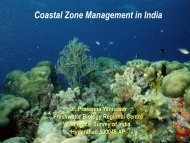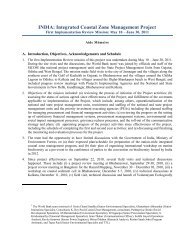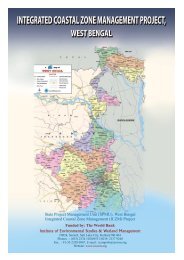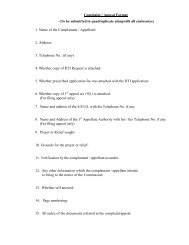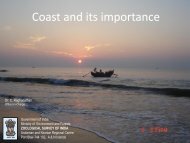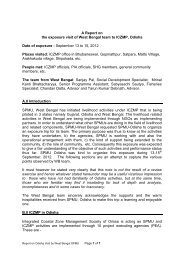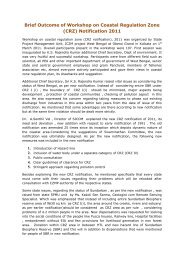Cyclone and Storm Surge - Iczmpwb.org
Cyclone and Storm Surge - Iczmpwb.org
Cyclone and Storm Surge - Iczmpwb.org
You also want an ePaper? Increase the reach of your titles
YUMPU automatically turns print PDFs into web optimized ePapers that Google loves.
Chapter Two<br />
Tropical <strong>Cyclone</strong>s <strong>and</strong> their Effects in West Bengal<br />
2.1. General Introduction<br />
Technically, the cyclone affecting the coast of West Bengal, <strong>and</strong> indeed the remaining of coast of the<br />
country, is called the Tropical <strong>Cyclone</strong> which is a storm system with a closed circulation around a<br />
centre of low pressure, driven by the heat released when moist air rises <strong>and</strong> condenses. As the name<br />
suggests, the origin of these is in the tropics <strong>and</strong> has an anticlockwise circulation in the northern<br />
hemisphere. Tropical cyclones can produce extremely high winds, generate torrential rain, <strong>and</strong> drive<br />
up the ocean water against the coast resulting in a storm surge. The effects of a cyclone on a<br />
population can be catastrophic <strong>and</strong> as has been recorded in the historical annals of exceptional<br />
cyclones, the storm of 1737 has been one of the worst, which had devastated the city of Kolkata<br />
(Calcutta then). Though many accounts prevail, Bilham (1994) evaluates the event more rationally by<br />
examining many contemporary documents <strong>and</strong> concludes that a cyclonic storm had caused a huge<br />
wave to rush up the river Hooghly (reportedly 40 feet high) <strong>and</strong> destroy many fishing boats <strong>and</strong> ships.<br />
Evidences also show that the strength of the storm had caused destruction of most of the thatched<br />
houses belonging to the local population. The spire of St. Anne’s church within Fort William (later<br />
destroyed during Siraj-ud-Daula’s campaign) had probably toppled due to the gust of the cyclonic<br />
winds. Though this kind of cyclonic devastation has not been experienced by Kolkata since then, but<br />
it may be presumed that such an event could have been one of an extreme kind in which the cyclone<br />
track had been coincident with the path of the river Hooghly. This might explain the huge upsurge of<br />
a wave <strong>and</strong> devastation of houses by winds. It is possible that the waves penetrated 60 leagues<br />
(nearly 300 kms) inl<strong>and</strong> from the mouth of the bay, as one may see from the remnants of the mast of<br />
the Portugese ship that ran aground near B<strong>and</strong>el <strong>and</strong> has been kept for public viewing at the old<br />
church compound there.<br />
CHAPTER 2<br />
Other notable cyclones originating in the northern Indian Ocean are seen to have either hit the coast<br />
of West Bengal or have grazed menacingly close by. For example, the severe tropical cyclone hit<br />
Kolkata in 1864, reportedly killing nearly 60,000 people. This event <strong>and</strong> the subsequent famines in<br />
1866 <strong>and</strong> 1871 led to the formation of the India Meteorological Department. The cyclonic devastation<br />
of October 1942 is also reported to have been quite high, with wind speeds <strong>and</strong> Sagar Isl<strong>and</strong>s being<br />
recorded to be as high as nearly 165 km per hour. The next severe cyclone that finds mention in this







